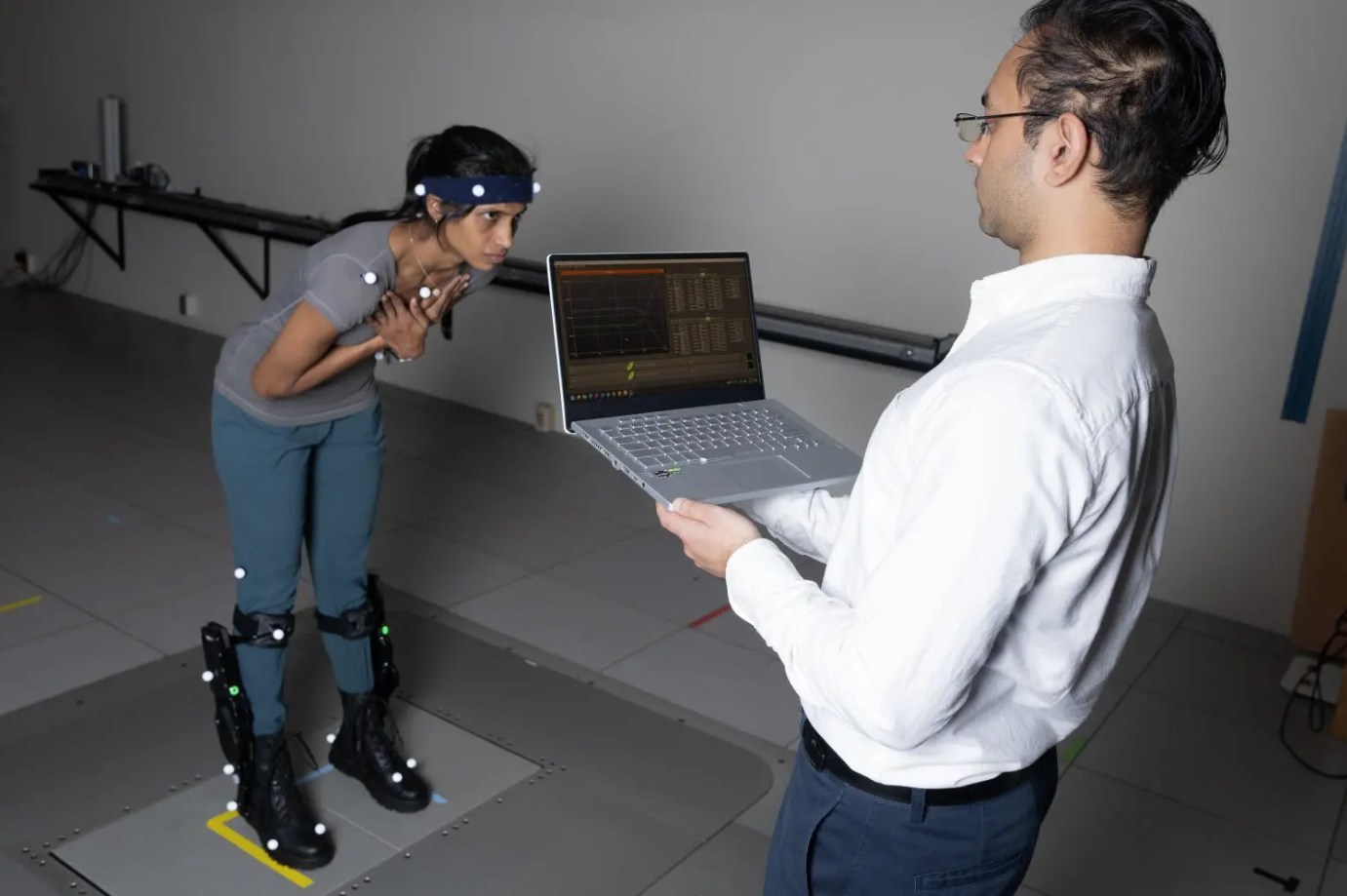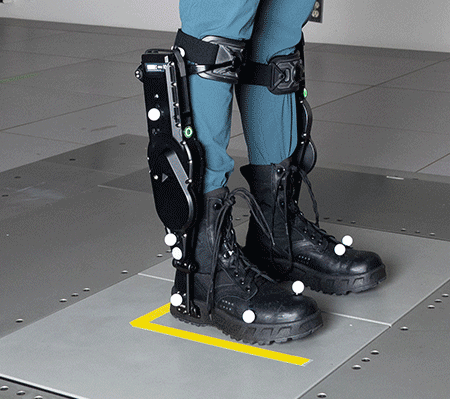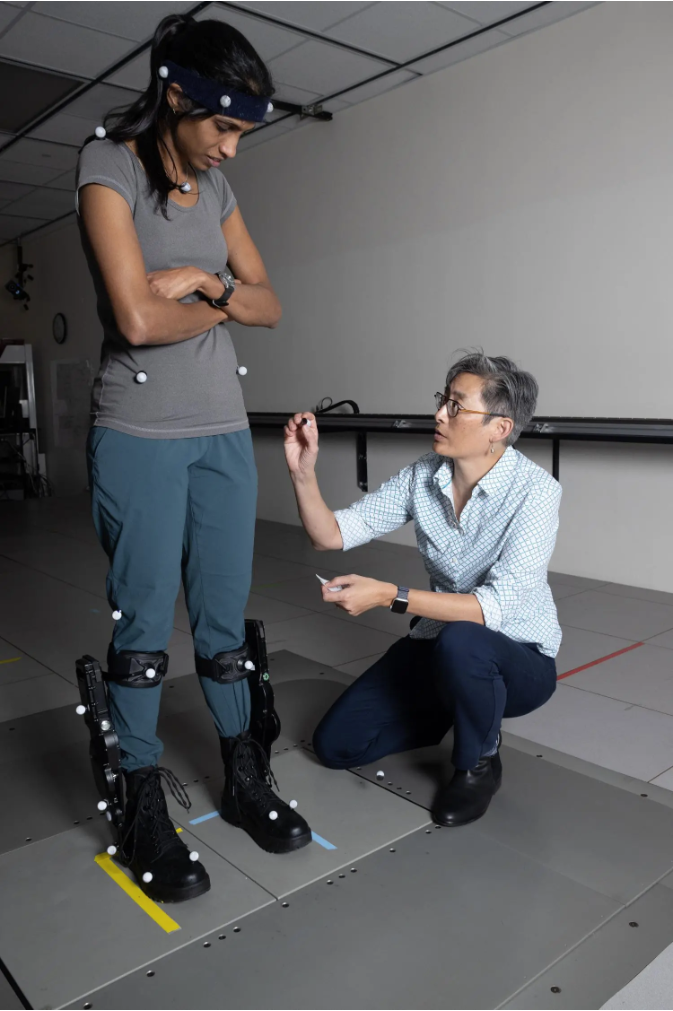
Postdoctoral fellow Surabhi Simha demonstrates how researchers tested whether robotic ankle exoskeleton boots can help people with their balance when its disrupted. Subjects wore sensors for motion capture, muscle activity, and ultrasound while they stood on a platform that shifts abruptly to disrupt their balance. Research engineer Rish Rastogi, right, monitors some of the data being collected.
To Help Recover Balance, Robotic Exoskeletons Have to be Faster Than Human Reflexes
Researchers at Georgia Tech and Emory found wearable ankle exoskeletons helped subjects improve standing balance only if they activated before muscles fired.
February 15, 2023
By Joshua Stewart, Photos by Candler Hobbs
Wearable robotics promise to help older people retain their mobility and paraplegic patients regain theirs. They could help make humans stronger and faster. But, so far, they’re not great at keeping people from falling.
Human balance is a complicated dance, and even the most advanced robots and wearables like robotic exoskeletons have trouble replicating how our brains and bodies work together to keep us upright. A new study from researchers at the Georgia Institute of Technology and Emory University is taking the first step toward addressing the balance problem.
In a paper published Feb. 15 in Science Robotics, the group showed an ankle exoskeleton must react faster than our bodies to improve balance. Participants didn’t recover any more quickly when the exoskeleton delayed applying power until the same time muscles in the leg and ankle activated to restore balance.
“It was surprising that using physiologically delayed assistance from the exoskeletons didn't help at all,” said Max Shepherd, a postdoctoral fellow at Georgia Tech during the study and now an assistant professor at Northeastern University. “I was surprised about the results — pleasantly surprised. I think it's a very fascinating result.”
The team used a pair of commercially available ankle exoskeleton boots from Dephy Inc. for the study. Participants donned the boots and stood on a custom platform in Lena Ting’s Neuromechanics Lab at Emory University.
 Researchers shifted the platform abruptly — what they call a perturbation — causing subjects to lose their balance and recover. They tested three conditions: no exoskeleton assistance, assistance delayed to coincide with the body’s natural reaction, and assistance faster than the physiological response. They reported that delivering ankle exoskeleton torque before the body’s natural response enabled the subjects to withstand 9% larger perturbations without taking a step; delaying the torque didn’t show any improvement.
Researchers shifted the platform abruptly — what they call a perturbation — causing subjects to lose their balance and recover. They tested three conditions: no exoskeleton assistance, assistance delayed to coincide with the body’s natural reaction, and assistance faster than the physiological response. They reported that delivering ankle exoskeleton torque before the body’s natural response enabled the subjects to withstand 9% larger perturbations without taking a step; delaying the torque didn’t show any improvement.
“A lot of prostheses or exoskeletons are driven by the physiological signals coming from the human wearer, either their muscle activity or their brain activity,” said Ting, professor and McCamish Foundation Distinguished Chair in the Wallace H. Coulter Department of Biomedical Engineering at Georgia Tech and Emory. “You measure the muscle around the ankle and whenever it goes on, you turn on the exo. The implication here is, that's not going to work for balance.”
The findings “flip the narrative a bit” for these kinds of robotic tools, as co-author Greg Sawicki put it.
“The predominant control approach is to steal the human response and then just layer on to it. What we show in this study is that's definitely not going to be good enough, at least for standing balance,” said Sawicki, associate professor in the George W. Woodruff School of Mechanical Engineering and the School of Biological Sciences.
Shepherd said not being able to simply follow the body’s own reactions to drive the exoskeleton’s activation makes it harder to create a device that can help people recover their balance in real-world situations. But it also presents exciting avenues for researchers to pursue, including using machine learning approaches to detect and respond to perturbations.
It takes just 150 milliseconds or so for the body to react to losing balance, so the ankle exoskeletons had an exceedingly small window to activate if they were to beat the physiological response. In their experiments, the team used accelerometers similar to those found in smartphones to track the acceleration of the foot during the perturbation and trigger activation of the exo-boots.

A smarter controller infused with some form of machine learning eventually could be promising. But, interestingly, the data to feed those algorithms likely would need to come from far beyond just the ankle.
The researchers reported that the artificially fast assistance from the exoskeleton disrupted the initial motion of the ankle, even though the muscle activity was consistent whether the boots activated or not. In fact, the local signal at the ankle would have caused the exoskeleton to provide torque in the wrong direction, which would be more destabilizing.
The team said that supports the notion that muscles are driven not just by local sensory information at the ankle but by information from throughout the body.
Ting said studies dating back nearly 50 years have suggested the global physiological signals would be better at predicting the body’s balance-correcting behavior than local information from just the ankle and leg. But those studies hadn’t been tested in this way.
“The idea is that your center of mass, which is basically the net motion of your entire body, drives what the ankle muscle needs to do,” said Ting, who also is a professor in the Department of Rehabilitation Medicine at Emory. “What I like about our findings is they modernize this story from the 1970s and show it in very clear and applicable terms. And I liked that this exo is now potentially an experimental device for our lab to actually demonstrate which signal to use when a local signal conflicts with a global signal.”
In addition to Ting, Sawicki, and Shepherd, the study’s authors also included Owen Beck, a postdoctoral fellow in Sawicki’s lab and now an assistant professor at the University of Texas at Austin; Emory research engineer Rish Rastogi; and postdoc Giovanni Martino, who’s soon to be an assistant professor at the University of Padua in Italy.
“One thing that’s really special about this is, we were able to ask a very specific question about the interaction between the exoskeleton and human and understand a bit more about how exoskeleton either helps or disrupts human physiological responses,” Shepherd said. “This study is a very clean way to offer insight into improving balance, which could become a very, very big sub field within exoskeletons.”
To round out their understanding, the team used motion capture technology and wired participants with electromyography (EMG) and ultrasound sensors so they could track in detail not just how the ankle and exo-boots worked together — or against each other — but also how the muscles fired and how strongly.
“This is more than just blasting people with robotic power and seeing what happens. We're also explaining why and what happens under the skin,” Sawicki said. “That's an important path forward for engineering design. It's also a signal that you need to have some physiologists around your robotics labs, and you need to have some engineers around your physiology labs.”
About the Research
This research was supported by the McCamish Parkinson’s Disease Innovation Program at Georgia Tech and Emory and the National Institutes of Health, grant Nos. F32 AG063460, R01 HD46922, R01 AG058615, and R01 HD90642. Any opinions, findings, and conclusions or recommendations expressed in this material are those of the authors and do not necessarily reflect the views of any funding agency.
CITATION: Beck ON, Shepherd MK, Rastogi R, Martino G, Ting LH, and Sawicki GS. “Exoskeletons need to react faster than physiological responses to improve standing balance.” Sci. Robot. 8, eadf1080 (2023). https://doi.org/10.1126/scirobotics.adf1080
